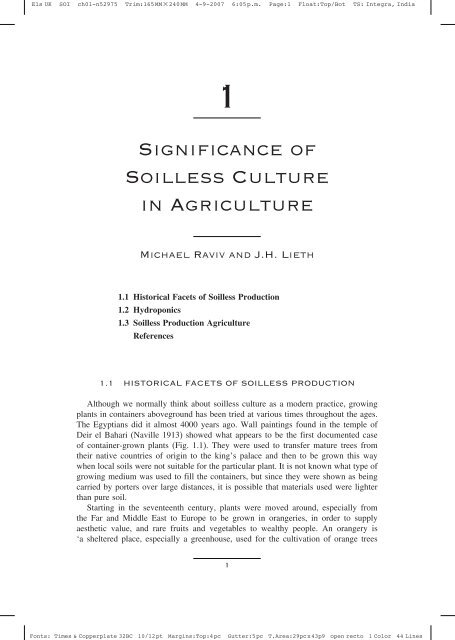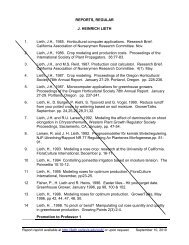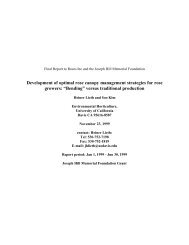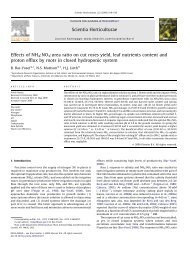1 Significance of Soilless Culture in Agriculture
1 Significance of Soilless Culture in Agriculture
1 Significance of Soilless Culture in Agriculture
You also want an ePaper? Increase the reach of your titles
YUMPU automatically turns print PDFs into web optimized ePapers that Google loves.
Els UK SOI ch01-n52975 Trim:165MM×240MM 4-9-2007 6:05p.m. Page:1 Float:Top/Bot TS: Integra, India<br />
1<br />
<strong>Significance</strong> <strong>of</strong><br />
<strong>Soilless</strong> <strong>Culture</strong><br />
<strong>in</strong> <strong>Agriculture</strong><br />
Michael Raviv and J.H. Lieth<br />
1.1 Historical Facets <strong>of</strong> <strong>Soilless</strong> Production<br />
1.2 Hydroponics<br />
1.3 <strong>Soilless</strong> Production <strong>Agriculture</strong><br />
References<br />
1.1 HISTORICAL FACETS OF SOILLESS PRODUCTION<br />
Although we normally th<strong>in</strong>k about soilless culture as a modern practice, grow<strong>in</strong>g<br />
plants <strong>in</strong> conta<strong>in</strong>ers aboveground has been tried at various times throughout the ages.<br />
The Egyptians did it almost 4000 years ago. Wall pa<strong>in</strong>t<strong>in</strong>gs found <strong>in</strong> the temple <strong>of</strong><br />
Deir el Bahari (Naville 1913) showed what appears to be the first documented case<br />
<strong>of</strong> conta<strong>in</strong>er-grown plants (Fig. 1.1). They were used to transfer mature trees from<br />
their native countries <strong>of</strong> orig<strong>in</strong> to the k<strong>in</strong>g’s palace and then to be grown this way<br />
when local soils were not suitable for the particular plant. It is not known what type <strong>of</strong><br />
grow<strong>in</strong>g medium was used to fill the conta<strong>in</strong>ers, but s<strong>in</strong>ce they were shown as be<strong>in</strong>g<br />
carried by porters over large distances, it is possible that materials used were lighter<br />
than pure soil.<br />
Start<strong>in</strong>g <strong>in</strong> the seventeenth century, plants were moved around, especially from<br />
the Far and Middle East to Europe to be grown <strong>in</strong> orangeries, <strong>in</strong> order to supply<br />
aesthetic value, and rare fruits and vegetables to wealthy people. An orangery is<br />
‘a sheltered place, especially a greenhouse, used for the cultivation <strong>of</strong> orange trees<br />
1<br />
Fonts: Times & Copperplate 32BC 10/12pt Marg<strong>in</strong>s:Top:4pc Gutter:5pc T.Area:29pcx43p9 open recto 1 Color 44 L<strong>in</strong>es
Els UK SOI ch01-n52975 Trim:165MM×240MM 4-9-2007 6:05p.m. Page:2 Float:Top/Bot TS: Integra, India<br />
2 Chapter 1 <strong>Significance</strong> <strong>of</strong> <strong>Soilless</strong> <strong>Culture</strong> <strong>in</strong> <strong>Agriculture</strong><br />
FIGURE 1.1 Early recorded <strong>in</strong>stance <strong>of</strong> plant production and transportation, recorded <strong>in</strong> the temple<br />
<strong>of</strong> Hatshepsut, Deir el-Bahri, near Thebes, Egypt (Naville, 1913; Matk<strong>in</strong> et al., 1957).<br />
AU1<br />
AU2<br />
<strong>in</strong> cool climates’ (American Heritage Dictionary), so it can be regarded as the first<br />
documented case <strong>of</strong> a greenhouse conta<strong>in</strong>er-grown system, although soil was mostly<br />
used to fill these conta<strong>in</strong>ers. Orangeries can still be found today throughout Europe.<br />
An exquisite example from Moscow, Russia, is shown <strong>in</strong> Figs. 1.2A and 1.2B.<br />
Fonts: Times & Copperplate 32BC 10/12pt Marg<strong>in</strong>s:Top:4pc Gutter:5pc T.Area:29pcx43p9 open recto 1 Color 44 L<strong>in</strong>es
Els UK SOI ch01-n52975 Trim:165MM×240MM 4-9-2007 6:05p.m. Page:3 Float:Top/Bot TS: Integra, India<br />
1.1 Historical Facets <strong>of</strong> <strong>Soilless</strong> Production 3<br />
FIGURE 1.2A Orangery <strong>in</strong> Kuskovo, Moscow (1761–1764) (see also Plate 1; with k<strong>in</strong>d permission<br />
<strong>of</strong> photographer Alexei Trosh<strong>in</strong> and Wikipedia – The Free Encyclopedia, http://en.wikipedia.org/wiki/<br />
Image:Kuskovo_orangerie.jpg).<br />
FIGURE 1.2B The orangerie at Pillnitz Palace near Dresden, Germany (see also Plate 2).<br />
Fonts: Times & Copperplate 32BC 10/12pt Marg<strong>in</strong>s:Top:4pc Gutter:5pc T.Area:29pcx43p9 open recto 1 Color 44 L<strong>in</strong>es
Els UK SOI ch01-n52975 Trim:165MM×240MM 4-9-2007 6:05p.m. Page:4 Float:Top/Bot TS: Integra, India<br />
4 Chapter 1 <strong>Significance</strong> <strong>of</strong> <strong>Soilless</strong> <strong>Culture</strong> <strong>in</strong> <strong>Agriculture</strong><br />
The orangerie at Pillnitz Palace near Dresden Germany was used to protect<br />
conta<strong>in</strong>er-grown citrus trees dur<strong>in</strong>g the w<strong>in</strong>ter. Large doors at the east side allowed<br />
trees to be moved <strong>in</strong> and out so that they could be grown outdoors dur<strong>in</strong>g the summer<br />
and brought <strong>in</strong>side dur<strong>in</strong>g the w<strong>in</strong>ter. Large floor-to-ceil<strong>in</strong>g w<strong>in</strong>dows on the south side<br />
allowed for sunlight to enter.<br />
As suggested by the name, the first plants to be grown <strong>in</strong> orangeries were different<br />
species <strong>of</strong> citruses. An artistic example can be seen <strong>in</strong> Fig. 1.3.<br />
Two major steps were key to the advancement <strong>of</strong> the production <strong>of</strong> plants <strong>in</strong><br />
conta<strong>in</strong>ers. One was the understand<strong>in</strong>g <strong>of</strong> plant nutritional requirements, pioneered by<br />
French and German scientists <strong>in</strong> the n<strong>in</strong>eteenth century, and later perfected by ma<strong>in</strong>ly<br />
American and English scientists dur<strong>in</strong>g the first half <strong>of</strong> the twentieth century. As late as<br />
1946, British scientists still claimed that while it is possible to grow plants <strong>in</strong> silica sand<br />
us<strong>in</strong>g nutrient solutions, similarly treated soil-grown plants produced more yield and<br />
biomass (Woodman and Johnson, 1946 a,b). It was not until the 1970s that researchers<br />
developed complete nutrient solutions, coupled their use to appropriate root<strong>in</strong>g media<br />
FIGURE 1.3 Orangery (from The Nederlanze Hesperides by Jan Commel<strong>in</strong>, 1676).<br />
Fonts: Times & Copperplate 32BC 10/12pt Marg<strong>in</strong>s:Top:4pc Gutter:5pc T.Area:29pcx43p9 open recto 1 Color 44 L<strong>in</strong>es
Els UK SOI ch01-n52975 Trim:165MM×240MM 4-9-2007 6:05p.m. Page:5 Float:Top/Bot TS: Integra, India<br />
1.1 Historical Facets <strong>of</strong> <strong>Soilless</strong> Production 5<br />
and studied how to optimize the levels <strong>of</strong> nutrients, water and oxygen to demonstrate<br />
the superiority <strong>of</strong> soilless media <strong>in</strong> terms <strong>of</strong> yield (Cooper, 1975; Verwer, 1977).<br />
The second major step was the realization that elim<strong>in</strong>ation <strong>of</strong> disease organisms<br />
that needed to be controlled through dis<strong>in</strong>festation was feasible <strong>in</strong> conta<strong>in</strong>er-grown<br />
production while be<strong>in</strong>g virtually impossible <strong>in</strong> soil-grown plants. In the United States,<br />
a key document was the description <strong>of</strong> a production system that provided a manual for<br />
the use <strong>of</strong> substrates <strong>in</strong> conjunction with disease control for production <strong>of</strong> conta<strong>in</strong>ergrown<br />
plants <strong>in</strong> outdoor nursery production. Entitled The U.C. System for Produc<strong>in</strong>g<br />
Healthy Conta<strong>in</strong>er-grown Plants through the use <strong>of</strong> clean Soil, Clean Stock, and<br />
Sanitation (Baker, 1957), it was a breakthrough <strong>in</strong> conta<strong>in</strong>er nursery production <strong>in</strong><br />
the 1950s and 1960s and helped growers to such an extent that it became universally<br />
adopted s<strong>in</strong>ce growers us<strong>in</strong>g the system had a dramatic economic advantage over<br />
competitors that did not use it. This manual described several grow<strong>in</strong>g media mixes<br />
consist<strong>in</strong>g <strong>of</strong> sand and organic matter such as peat, bark or sawdust <strong>in</strong> various specific<br />
percentages (Matk<strong>in</strong> and Chandler, 1957). These became known as ‘UC mixes’. It<br />
should be noted that <strong>in</strong> this manual these mixes are called ‘soil’ or ‘soil mixes’, largely<br />
because prior to that time most conta<strong>in</strong>er media consisted <strong>of</strong> a mix <strong>of</strong> soil and various<br />
other materials. That convention is not used <strong>in</strong> this book; here we treat the term ‘soil’<br />
as mean<strong>in</strong>g only a particular comb<strong>in</strong>ation <strong>of</strong> sand, silt, clay and organic matter found<br />
<strong>in</strong> the ground. Thus, when we talk about soilless substrates <strong>in</strong> this book, they may<br />
<strong>in</strong>clude m<strong>in</strong>eral components (such as sand or clay) that are also found <strong>in</strong> soil, but not<br />
soil directly. The term ‘compost’ was also used as a synonym to ‘soil mix’ for many<br />
years, especially <strong>in</strong> Europe and the United K<strong>in</strong>gdom (Rob<strong>in</strong>son and Lamb, 1975), but<br />
also <strong>in</strong> the United States (Boodley and Sheldrake, 1973). This term <strong>in</strong>cluded what is<br />
now usually termed ‘substrate’ or ‘grow<strong>in</strong>g medium’ and, <strong>in</strong> most cases, suggests the<br />
use <strong>of</strong> mix <strong>of</strong> different components, with at least one <strong>of</strong> them be<strong>in</strong>g <strong>of</strong> organic orig<strong>in</strong>.<br />
In this book, we use the term ‘grow<strong>in</strong>g medium’ and ‘substrate’ <strong>in</strong>terchangeably.<br />
These scientific developments dispelled the notion that grow<strong>in</strong>g media can be<br />
assembled by haphazardly comb<strong>in</strong><strong>in</strong>g some soil and other materials to create ‘pott<strong>in</strong>g<br />
soil’. This notion was supported <strong>in</strong> the past by the fact that much <strong>of</strong> the development<br />
<strong>of</strong> ideal grow<strong>in</strong>g media was done by trial and error. Today we have a fairly<br />
complete picture <strong>of</strong> the important physical and chemical characteristics (described <strong>in</strong><br />
Chaps. 3 and 6, respectively), which are achieved through the comb<strong>in</strong>ation <strong>of</strong> specific<br />
components (e.g. UC mix) or through <strong>in</strong>dustrial manufacture (e.g. stone wool slabs).<br />
Throughout the world there are many local and regional implementations <strong>of</strong> these<br />
concepts. These are generally driven by both horticultural and f<strong>in</strong>ancial considerations.<br />
While the horticultural considerations are covered <strong>in</strong> this book, the f<strong>in</strong>ancial<br />
considerations are not. Yet this factor is ultimately the major driv<strong>in</strong>g force for the<br />
formulation <strong>of</strong> a particular substrate mix that ends up <strong>in</strong> use <strong>in</strong> a soilless production sett<strong>in</strong>g.<br />
The f<strong>in</strong>ancial factor manifests itself through availability <strong>of</strong> materials, process<strong>in</strong>g<br />
costs, transportation costs and costs associated with production <strong>of</strong> plants/crops as well<br />
as their transportation and market<strong>in</strong>g. Disposal <strong>of</strong> used substrates is, <strong>in</strong> some cases,<br />
another important consideration <strong>of</strong> both environmental and economical implications.<br />
For example, one <strong>of</strong> the major problems <strong>in</strong> the horticultural use <strong>of</strong> m<strong>in</strong>eral wool<br />
Fonts: Times & Copperplate 32BC 10/12pt Marg<strong>in</strong>s:Top:4pc Gutter:5pc T.Area:29pcx43p9 open recto 1 Color 44 L<strong>in</strong>es
Els UK SOI ch01-n52975 Trim:165MM×240MM 4-9-2007 6:05p.m. Page:6 Float:Top/Bot TS: Integra, India<br />
6 Chapter 1 <strong>Significance</strong> <strong>of</strong> <strong>Soilless</strong> <strong>Culture</strong> <strong>in</strong> <strong>Agriculture</strong><br />
(stone- and glass-wool) is its safe disposal, as it is not a natural resource that can be<br />
returned back to nature. Various methods <strong>of</strong> stone-wool recycl<strong>in</strong>g have been developed<br />
but they all put a certa<strong>in</strong> amount <strong>of</strong> f<strong>in</strong>ancial burden on the end-user.<br />
In countries where peat is readily available, perhaps even harvested locally, growers<br />
f<strong>in</strong>d this material to be less expensive than <strong>in</strong> countries where it has to be imported<br />
from distant locations. As prices <strong>of</strong> raw materials fluctuate, growers must evaluate<br />
whether to use a ‘tried and true’ component (e.g. peat) or a replacement (e.g. coconut<br />
coir) <strong>in</strong> a recipe that may have proven to work well over the years. In some years<br />
the f<strong>in</strong>ancial situation may force consideration <strong>of</strong> a change. S<strong>in</strong>ce the properties <strong>of</strong> all<br />
substrates and mixes differ from each other, replacement <strong>of</strong> one particular component<br />
(such as peat) with another component might result <strong>in</strong> other costs or lower quality<br />
crops (which may be valued less <strong>in</strong> the market place), especially if the substitution is<br />
a material with which the grower has less experience. Thus growers throughout the<br />
world face the challenge <strong>of</strong> assembl<strong>in</strong>g mixes that will perform as desired at the lowest<br />
possible overall cost.<br />
The result <strong>of</strong> this is that the substrates used throughout the world differ significantly<br />
as to their make-up, while attempt<strong>in</strong>g to adhere to a specific set <strong>of</strong> pr<strong>in</strong>ciples. These<br />
pr<strong>in</strong>ciples are quite complex, relat<strong>in</strong>g to physical and chemical factors <strong>of</strong> solids, liquids<br />
and gasses <strong>in</strong> the root zone <strong>of</strong> the plant.<br />
Today the largest <strong>in</strong>dustries <strong>in</strong> which soilless production dom<strong>in</strong>ates are greenhouse<br />
production <strong>of</strong> ornamentals and vegetables and outdoor conta<strong>in</strong>er nursery production. In<br />
urban horticulture, virtually all conta<strong>in</strong>erized plants are grown without any field soil.<br />
1.2 HYDROPONICS<br />
Grow<strong>in</strong>g plants without soil has also been achieved through water culture without<br />
the use <strong>of</strong> any solid substrates. This type <strong>of</strong> soilless production is frequently termed<br />
‘hydroponics’. While this term was co<strong>in</strong>ed by Gericke (1937) to mean water culture<br />
without employ<strong>in</strong>g any substrate, currently the term is used to mean various th<strong>in</strong>gs to<br />
various persons. Many use the term to refer to systems that do <strong>in</strong>clude some sort <strong>of</strong><br />
substrate to anchor or stabilize the plant and to provide an <strong>in</strong>ert matrix to hold water.<br />
Strictly speak<strong>in</strong>g, however, hydroponics is the practice <strong>of</strong> grow<strong>in</strong>g plants <strong>in</strong> nutrient<br />
solutions. In addition to systems that use exclusively nutrient solution and air (e.g.<br />
NFT, DFT, aerohydroponics), we also <strong>in</strong>clude <strong>in</strong> this concept those substrate-based<br />
systems, where the substrate contributes no nutrients nor ionic adsorption or exchange.<br />
Thus we consider production systems with <strong>in</strong>ert substrates such as stone wool or gravel<br />
to be hydroponic. But despite this del<strong>in</strong>eation, we have <strong>in</strong> this book generally avoided<br />
the use <strong>of</strong> the term ‘hydroponics’ due to the fact that not every one agrees on this<br />
del<strong>in</strong>eation.<br />
Initially scientists used hydroponics ma<strong>in</strong>ly as a research tool to study particular<br />
aspects <strong>of</strong> plant nutrition and root function. Progress <strong>in</strong> plastics manufactur<strong>in</strong>g, automation,<br />
production <strong>of</strong> completely soluble fertilizers and especially the development<br />
<strong>of</strong> many types <strong>of</strong> substrates complemented the scientific achievements and brought<br />
Fonts: Times & Copperplate 32BC 10/12pt Marg<strong>in</strong>s:Top:4pc Gutter:5pc T.Area:29pcx43p9 open recto 1 Color 44 L<strong>in</strong>es
Els UK SOI ch01-n52975 Trim:165MM×240MM 4-9-2007 6:05p.m. Page:7 Float:Top/Bot TS: Integra, India<br />
1.3 <strong>Soilless</strong> Production <strong>Agriculture</strong> 7<br />
soilless cutivation to a viable commercial stage. Today various types <strong>of</strong> soilless systems<br />
exist for grow<strong>in</strong>g vegetables and ornamentals <strong>in</strong> greenhouses. This has resulted with a<br />
wide variety <strong>of</strong> grow<strong>in</strong>g systems; the most important <strong>of</strong> these are described <strong>in</strong> Chap. 5.<br />
1.3 SOILLESS PRODUCTION AGRICULTURE<br />
World agriculture has changed dramatically over the last few decades, and this<br />
change cont<strong>in</strong>ues, s<strong>in</strong>ce the driv<strong>in</strong>g forces for these changes are still <strong>in</strong> place. These<br />
forces consist <strong>of</strong> the rapid scientific, economic and technological development <strong>of</strong><br />
societies throughout the world. The <strong>in</strong>crease <strong>in</strong> worlds’ population and the improvement<br />
<strong>in</strong> the standard <strong>of</strong> liv<strong>in</strong>g <strong>in</strong> many countries have created a strong demand for high-value<br />
foods and ornamentals and particularly for out-<strong>of</strong>-season, high-quality products. The<br />
demand for floricultural crops, <strong>in</strong>clud<strong>in</strong>g cut flowers, pot plants and bedd<strong>in</strong>g plants,<br />
has also grown dramatically. The result <strong>of</strong> these trends was the expanded use <strong>of</strong> a<br />
wide variety <strong>of</strong> protected cultivation systems, rang<strong>in</strong>g from primitive screen or plastic<br />
film covers to completely controlled greenhouses. Initially this production was entirely<br />
<strong>in</strong> the ground where the soil had been modified so as to allow for good dra<strong>in</strong>age.<br />
S<strong>in</strong>ce the production costs <strong>of</strong> protected cultivation are higher than that <strong>of</strong> open-field<br />
production, growers had to <strong>in</strong>crease their production <strong>in</strong>tensity to stay competitive. This<br />
was achieved by several techniques; prom<strong>in</strong>ent among these is the rapid <strong>in</strong>crease <strong>in</strong><br />
soilless production relative to total agricultural crop production.<br />
The major cause for shift away from the use <strong>of</strong> soil was the proliferation <strong>of</strong> soilborne<br />
pathogens <strong>in</strong> <strong>in</strong>tensively cultivated greenhouses. Soil was replaced by various<br />
substrates, such as stone wool, polyurethane, perlite, scoria (tuff) and so on, s<strong>in</strong>ce they<br />
are virtually free <strong>of</strong> pests and diseases due to their manufactur<strong>in</strong>g process. Also <strong>in</strong><br />
reuse from crop to crop, these materials can be dis<strong>in</strong>fested between so as to kill any<br />
microorganisms. The cont<strong>in</strong>u<strong>in</strong>g shift to soilless cultivation is also driven by the fact<br />
that <strong>in</strong> soilless systems it is possible to have better control over several crucial factors,<br />
lead<strong>in</strong>g to greatly improved plant performance.<br />
Physical and hydraulic characteristics <strong>of</strong> most substrates are superior to those <strong>of</strong><br />
soils. A soil-grown plant experiences relatively high water availability immediately<br />
after irrigation. At this time the macropores are filled with water followed by relatively<br />
slow dra<strong>in</strong>age which is accompanied by entry <strong>of</strong> air <strong>in</strong>to the soil macropores. Oxygen,<br />
which is consumed by plant roots and soil micr<strong>of</strong>lora, is replenished at a rate which<br />
may be slower than plant demand. When enough water is dra<strong>in</strong>ed and evapotranspired,<br />
the porosity <strong>of</strong> the soil is such that atmospheric oxygen diffuses <strong>in</strong>to the root zone.<br />
At the same time, some water is held by gradually <strong>in</strong>creas<strong>in</strong>g soil matric forces so<br />
that the plant has to <strong>in</strong>vest a considerable amount <strong>of</strong> energy to take up enough water<br />
to compensate for transpiration losses due to atmospheric demand. Most substrates,<br />
on the other hand, allow a simultaneous optimization <strong>of</strong> both water and oxygen<br />
availabilities. The matric forces hold<strong>in</strong>g the water <strong>in</strong> substrates are much weaker than<br />
<strong>in</strong> soil. Consequently, plants grown <strong>in</strong> porous media at or near conta<strong>in</strong>er capacity<br />
require less energy to extract water. At the same time, a significant fraction <strong>of</strong> the<br />
AU3<br />
Fonts: Times & Copperplate 32BC 10/12pt Marg<strong>in</strong>s:Top:4pc Gutter:5pc T.Area:29pcx43p9 open recto 1 Color 44 L<strong>in</strong>es
Els UK SOI ch01-n52975 Trim:165MM×240MM 4-9-2007 6:05p.m. Page:8 Float:Top/Bot TS: Integra, India<br />
8 Chapter 1 <strong>Significance</strong> <strong>of</strong> <strong>Soilless</strong> <strong>Culture</strong> <strong>in</strong> <strong>Agriculture</strong><br />
AU4<br />
macropores is filled with air, and oxygen diffusion rate is high enough so that plants<br />
do not experience a risk <strong>of</strong> oxygen deficiency, such as experienced by plants grown<br />
<strong>in</strong> a soil near field capacity. This subject is quantitatively discussed <strong>in</strong> Chap. 3 and its<br />
practical translation <strong>in</strong>to irrigation control is described <strong>in</strong> Chap. 4.<br />
Another factor is that nutrient availability to plant roots can be better manipulated<br />
and controlled <strong>in</strong> soilless cultivation than <strong>in</strong> most arable soils. The surface charge and<br />
chemical characteristics <strong>of</strong> substrates are the subjects <strong>of</strong> Chap. 6, while plant nutrition<br />
requirement and the methods <strong>of</strong> satisfy<strong>in</strong>g these needs are treated <strong>in</strong> Chap. 8. Chapter 7<br />
is devoted to the description <strong>of</strong> the analytical methods, used to select adequate substrate<br />
for a specific aim, and other methods, used to control the nutritional status dur<strong>in</strong>g<br />
the cropp<strong>in</strong>g period, so as to provide the growers with recommendations, aimed at<br />
optimiz<strong>in</strong>g plant performance.<br />
Lack <strong>of</strong> suitable soils, disease contam<strong>in</strong>ation after repeated use and the desire<br />
to apply optimal conditions for plant growth are lead<strong>in</strong>g to the worldwide trend <strong>of</strong><br />
grow<strong>in</strong>g plants <strong>in</strong> soilless media. Most such plants are grown <strong>in</strong> greenhouses, generally<br />
under near-optimal production conditions. An <strong>in</strong>herent drawback <strong>of</strong> soilless vs. soilbased<br />
cultivation is the fact that <strong>in</strong> the latter the root volume is unrestricted while<br />
<strong>in</strong> conta<strong>in</strong>erized culture the root volume is restricted. This restricted root volume<br />
has several important effects, especially a limited supply <strong>of</strong> nutrients (Dubik et al.,<br />
1990; Bar-Tal, 1999). The limited root volume also <strong>in</strong>creases root-to-root competition<br />
s<strong>in</strong>ce there are more roots per unit volume <strong>of</strong> medium. Chapter 2 discusses the ma<strong>in</strong><br />
functions <strong>of</strong> the root system while Chap. 13 quantitatively analyses the limitations<br />
imposed by a restricted root volume. Various substrates <strong>of</strong> organic orig<strong>in</strong> are described<br />
<strong>in</strong> Chap. 11, while Chap. 12 describes substrates <strong>of</strong> <strong>in</strong>organic orig<strong>in</strong> and the issue <strong>of</strong><br />
pott<strong>in</strong>g mixes. In both the chapters, subjects such as production, orig<strong>in</strong>, physical and<br />
chemical characteristics, sterilization, re-use and waste disposal are discussed.<br />
Conta<strong>in</strong>er production systems have advantages over <strong>in</strong>-ground production systems<br />
<strong>in</strong> terms <strong>of</strong> pollution prevention s<strong>in</strong>ce it is possible, us<strong>in</strong>g these grow<strong>in</strong>g systems, to<br />
m<strong>in</strong>imize or elim<strong>in</strong>ate the discharge <strong>of</strong> nutritional ions and pesticide residues thus<br />
conserv<strong>in</strong>g freshwater reservoirs. Simultaneously, water- and nutrient-use efficiencies<br />
are typically significantly greater <strong>in</strong> conta<strong>in</strong>er production, result<strong>in</strong>g <strong>in</strong> clear economic<br />
benefits. Throughout the developed countries more and more attention is be<strong>in</strong>g directed<br />
to reduc<strong>in</strong>g environmental pollution, and <strong>in</strong> the countries where this type <strong>of</strong> production<br />
represent a large portion <strong>of</strong> agricultural productivity, regulations are be<strong>in</strong>g created<br />
to force recirculation so as to m<strong>in</strong>imize or elim<strong>in</strong>ate run-<strong>of</strong>f from the nurseries and<br />
greenhouses. The advantages and constra<strong>in</strong>ts <strong>of</strong> closed and semi-closed systems <strong>in</strong> an<br />
area that is currently see<strong>in</strong>g a lot <strong>of</strong> research and the state-<strong>of</strong>-the-art is described <strong>in</strong><br />
Chap. 9. The risk <strong>of</strong> disease proliferation <strong>in</strong> recirculated production and the methods<br />
to avert this risk are described <strong>in</strong> Chap. 10.<br />
The book concludes with a chapter (Chap. 13) deal<strong>in</strong>g with operational conclusions.<br />
In many cases practitioners are treat<strong>in</strong>g irrigation as separate from fertilization, and <strong>in</strong><br />
turn as separate from the design and creation <strong>of</strong> the substrate <strong>in</strong> which the plants are<br />
grown. This chapter addresses the root-zone as a dynamic system and shows how such<br />
a system is put together and how it is managed so as to optimize crop production, while<br />
Fonts: Times & Copperplate 32BC 10/12pt Marg<strong>in</strong>s:Top:4pc Gutter:5pc T.Area:29pcx43p9 open recto 1 Color 44 L<strong>in</strong>es
Els UK SOI ch01-n52975 Trim:165MM×240MM 4-9-2007 6:05p.m. Page:9 Float:Top/Bot TS: Integra, India<br />
1.3 <strong>Soilless</strong> Production <strong>Agriculture</strong> 9<br />
at the same time respect<strong>in</strong>g the factors imposed by society (run-<strong>of</strong>f elim<strong>in</strong>ation, labour<br />
sav<strong>in</strong>gs, etc.). Another subject which is mentioned <strong>in</strong> this chapter is the emerg<strong>in</strong>g trend<br />
<strong>of</strong> ‘Organic hydroponics’ which seems to ga<strong>in</strong> an <strong>in</strong>creas<strong>in</strong>g popularity <strong>in</strong> some parts<br />
<strong>of</strong> the world.<br />
One <strong>of</strong> the ma<strong>in</strong> future challenges for global horticulture is to produce adequate<br />
quantities <strong>of</strong> affordable food <strong>in</strong> less-developed countries. Simple, low-cost soilless<br />
production systems may be part <strong>of</strong> the solution to the problems created by the lack <strong>of</strong><br />
fertile soils and know-how. The fact that a relatively small cultivated area can provide<br />
food for a large population can stimulate this development. This, <strong>in</strong> turn, should<br />
stimulate pr<strong>of</strong>essionals to f<strong>in</strong>d alternatives to current expensive and high-tech pieces <strong>of</strong><br />
equipment and practices, to be suitable and durable for the needs <strong>of</strong> remote areas. One<br />
<strong>of</strong> the most important advantages <strong>of</strong> soilless cultivation deserves mention<strong>in</strong>g <strong>in</strong> this<br />
context: <strong>in</strong> most <strong>of</strong> the develop<strong>in</strong>g countries water is scarce and is <strong>of</strong> low quality. By<br />
superimpos<strong>in</strong>g the FAO’s hunger map (Fig. 1.4) on the aridity <strong>in</strong>dex map (Fig. 1.5),<br />
it is clear that <strong>in</strong> many regions <strong>of</strong> the world such as sub-Sahalian Africa, Namibia,<br />
Mongolia and so on, a large part <strong>of</strong> the population suffers hunger ma<strong>in</strong>ly due to<br />
water scarcity. S<strong>in</strong>ce water-use efficiency <strong>of</strong> soilless plant production (and especially<br />
<strong>in</strong> recirculated systems) is higher than that <strong>of</strong> soil-grown plants, more food can be<br />
FIGURE 1.4 Percentage <strong>of</strong> undernourished population around the globe (see also Plate 3; with k<strong>in</strong>d<br />
permission <strong>of</strong> the FAO).<br />
Fonts: Times & Copperplate 32BC 10/12pt Marg<strong>in</strong>s:Top:4pc Gutter:5pc T.Area:29pcx43p9 open recto 1 Color 44 L<strong>in</strong>es
Els UK SOI ch01-n52975 Trim:165MM×240MM 4-9-2007 6:05p.m. Page:10 Float:Top/Bot TS: Integra, India<br />
10 Chapter 1 <strong>Significance</strong> <strong>of</strong> <strong>Soilless</strong> <strong>Culture</strong> <strong>in</strong> <strong>Agriculture</strong><br />
FIGURE 1.5 Aridity <strong>in</strong>dex around the globe (see also Plate 4; with k<strong>in</strong>d permission <strong>of</strong> the FAO).<br />
AU5<br />
produced with such systems with less water. Also, plants grow<strong>in</strong>g <strong>in</strong> such systems can<br />
cope better with higher sal<strong>in</strong>ity levels than soil-grown plants. The reason for this is the<br />
connection between ample oxygen supply to the roots and their ability to exclude toxic<br />
ions such as Na + and to withstand high osmotic pressure (Kriedemann and Sands,<br />
1984; Drew and Dikumw<strong>in</strong>, 1985; Drew and Lauchli, 1985). It is <strong>in</strong>terest<strong>in</strong>g to note,<br />
<strong>in</strong> this respect, that soilless cultivation is practised <strong>in</strong> large scale <strong>in</strong> very arid regions<br />
such as most parts <strong>of</strong> Australia, parts <strong>of</strong> South Africa, Saudi Arabia and the southern<br />
part <strong>of</strong> Israel. In none <strong>of</strong> these countries, hunger is a problem.<br />
The science <strong>of</strong> plant production <strong>in</strong> soilless systems is still young, and although much<br />
work has been done, many questions still rema<strong>in</strong> unanswered. One <strong>of</strong> the purposes<br />
<strong>of</strong> this book is to focus on the ma<strong>in</strong> issues <strong>of</strong> the physical and chemical environment<br />
<strong>of</strong> the rhizosphere and to identify areas where future research is needed so as to take<br />
further advantage <strong>of</strong> the available substrates and to propose desirable characteristics<br />
for future substrates and grow<strong>in</strong>g practices to be developed by next generation <strong>of</strong><br />
researchers.<br />
REFERENCES<br />
Baker, K.F. (ed.) (1957). The U.C. System for Produc<strong>in</strong>g Healthy Conta<strong>in</strong>er-Grown Plants through the use<br />
<strong>of</strong> Clean Soil, Clean Stock, and Sanitation. University <strong>of</strong> California, Division <strong>of</strong> Agricultural Sciences,<br />
p. 332.<br />
Fonts: Times & Copperplate 32BC 10/12pt Marg<strong>in</strong>s:Top:4pc Gutter:5pc T.Area:29pcx43p9 open recto 1 Color 44 L<strong>in</strong>es
Els UK SOI ch01-n52975 Trim:165MM×240MM 4-9-2007 6:05p.m. Page:11 Float:Top/Bot TS: Integra, India<br />
References 11<br />
Bar-Tal, A. (1999). The significance <strong>of</strong> root size for plant nutrition <strong>in</strong> <strong>in</strong>tensive horticulture. In M<strong>in</strong>eral<br />
Nutrition <strong>of</strong> Crops: Fundamental Mechanisms and Implications (Z. Rengel, ed.). New York: Haworth<br />
Press, Inc., pp. 115–139.<br />
Boodley, J.W. and Sheldrake, R. Jr. (1973). Boron deficiency and petal necrosis <strong>of</strong> ‘Indianapolis White’<br />
chrysanthemum. HortScience, 8(1), 24–26.<br />
Cooper, A.J. (1975). Crop production <strong>in</strong> recirculat<strong>in</strong>g nutrient solution. Sci. Hort., 3, 251–258.<br />
Drew, M.C. and Dikumw<strong>in</strong>, E. (1985). Sodium exclusion from the shoots by roots <strong>of</strong> Zea mays (cv. LG 11)<br />
and its breakdown with oxygen deficiency. J. Exp. Bot., 36(162), 55–62.<br />
Drew, M.C. and Lauchli, A. (1985). Oxygen-dependent exclusion <strong>of</strong> sodium ions from shoots by roots <strong>of</strong><br />
Zea mays (cv. Pioneer 3906) <strong>in</strong> relation to sal<strong>in</strong>ity damage. Plant Physiol., 79(1), 171–176.<br />
Dubik, S.P., Krizek, D.T. and Stimart, D.P. (1990). Influence <strong>of</strong> root zone restriction on m<strong>in</strong>eral element<br />
concentration, water potential, chlorophyll concentration, and partition<strong>in</strong>g <strong>of</strong> assimilate <strong>in</strong> spread<strong>in</strong>g<br />
euonymus (E. kiautschovica Loes. ‘Sieboldiana’). J. Plant Nutr., 13, 677–699.<br />
Gericke, W.F. (1937). Hydroponics – crop production <strong>in</strong> liquid culture media. Science, 85, 177–178.<br />
Kriedemann, P.E. and Sands, R. (1984). Salt resistance and adaptation to root-zone hypoxia <strong>in</strong> sunflower.<br />
Aust. J. Pl. Physiol., 11(4): 287–301.<br />
Matk<strong>in</strong>, O.A. and Chandler, P.A. (1957). The U.C.-type soil mixes. In The U.C. System for Produc<strong>in</strong>g<br />
Healthy Conta<strong>in</strong>er-Grown Plants Through the Use <strong>of</strong> Clean Soil, Clean Stock, and Sanitation<br />
(K.F. Baker, ed.). University <strong>of</strong> California, Division <strong>of</strong> Agricultural Sciences, pp. 68–85.<br />
Matk<strong>in</strong>, O.A., Chandler, P.A. and Baker, K.F. (1957). Components and development <strong>of</strong> mixes. In The U.C.<br />
System for Produc<strong>in</strong>g Healthy Conta<strong>in</strong>er-grown Plants through the Use <strong>of</strong> Clean Soil, Clean Stock, and<br />
Sanitation (K.F. Baker, ed.). University <strong>of</strong> California, Division <strong>of</strong> Agricultural Sciences, pp. 86–107.<br />
Naville, E.H. (1913). The Temple <strong>of</strong> Deir el-Bahari (Parts I–III), Vol. 16. London: Memoirs <strong>of</strong> the Egypt<br />
Exploration Fund. pp. 12–17.<br />
Rob<strong>in</strong>son, D.W. and Lamb, J.G.D. (1975). Peat <strong>in</strong> Horticulture. Academic Press, London, xii, 170pp.<br />
Verwer, F.L.J.A.W. (1976). Grow<strong>in</strong>g horticultural crops <strong>in</strong> rockwool and nutrient film. In Proc. 4th Inter.<br />
Congr. On <strong>Soilless</strong> <strong>Culture</strong>. IWOSC, Las Palmas, pp. 107–119.<br />
Woodman, R.M. and Johnson, D.A. (1946a). Plant growth with nutrient solutions. II. A comparison <strong>of</strong> pure<br />
sand and fresh soil as the aggregate for plant growth. J. Agric. Sci., 36, 80–86.<br />
Woodman, R.M. and Johnson, D.A. (1946b). Plant growth with nutrient solutions. III. A comparison <strong>of</strong><br />
sand and soil as the aggregate for plant growth, us<strong>in</strong>g an optimum nutrient solution with the sand, and<br />
<strong>in</strong>complete supplies <strong>of</strong> nutrients with ‘once-used’ soil. J. Agric. Sci., 36, 87–94.<br />
AU6<br />
Fonts: Times & Copperplate 32BC 10/12pt Marg<strong>in</strong>s:Top:4pc Gutter:5pc T.Area:29pcx43p9 open recto 1 Color 44 L<strong>in</strong>es








